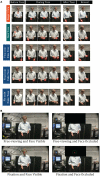Social misdirection fails to enhance a magic illusion
- PMID: 22046155
- PMCID: PMC3202226
- DOI: 10.3389/fnhum.2011.00103
Social misdirection fails to enhance a magic illusion
Abstract
Visual, multisensory and cognitive illusions in magic performances provide new windows into the psychological and neural principles of perception, attention, and cognition. We investigated a magic effect consisting of a coin "vanish" (i.e., the perceptual disappearance of a coin after a simulated toss from hand to hand). Previous research has shown that magicians can use joint attention cues such as their own gaze direction to strengthen the observers' perception of magic. Here we presented naïve observers with videos including real and simulated coin tosses to determine if joint attention might enhance the illusory perception of simulated coin tosses. The observers' eye positions were measured, and their perceptual responses simultaneously recorded via button press. To control for the magician's use of joint attention cues, we occluded his head in half of the trials. We found that subjects did not direct their gaze at the magician's face at the time of the coin toss, whether the face was visible or occluded, and that the presence of the magician's face did not enhance the illusion. Thus, our results show that joint attention is not necessary for the perception of this effect. We conclude that social misdirection is redundant and possibly detracting to this very robust sleight-of-hand illusion. We further determined that subjects required multiple trials to effectively distinguish real from simulated tosses; thus the illusion was resilient to repeated viewing.
Keywords: eye movements; fixation; free-viewing; join attention; motion perception; prestidigitation; sleight-of-hand; social misdirection.
Figures









References
-
- Ascanio A. (2005). The Magic of Ascanio: The Structural Conception of Magic. New York: Paginas
-
- Bour L. J., Aramideh M., De Visser B. W. O. (2000). Neurophysiological aspects of eye and eyelid movements during blinking in humans. J. Neurophysiol. 83, 166–176 - PubMed
-
- Harvery L. O. (2011). RscorePlus. Available at: http://psych.colorado.edu/(lharvey/ [accessed; Online].
-
- Hubel D. H. (1988). Eye, Brain, and Vision. New York: Scientific American Library
LinkOut - more resources
Full Text Sources

